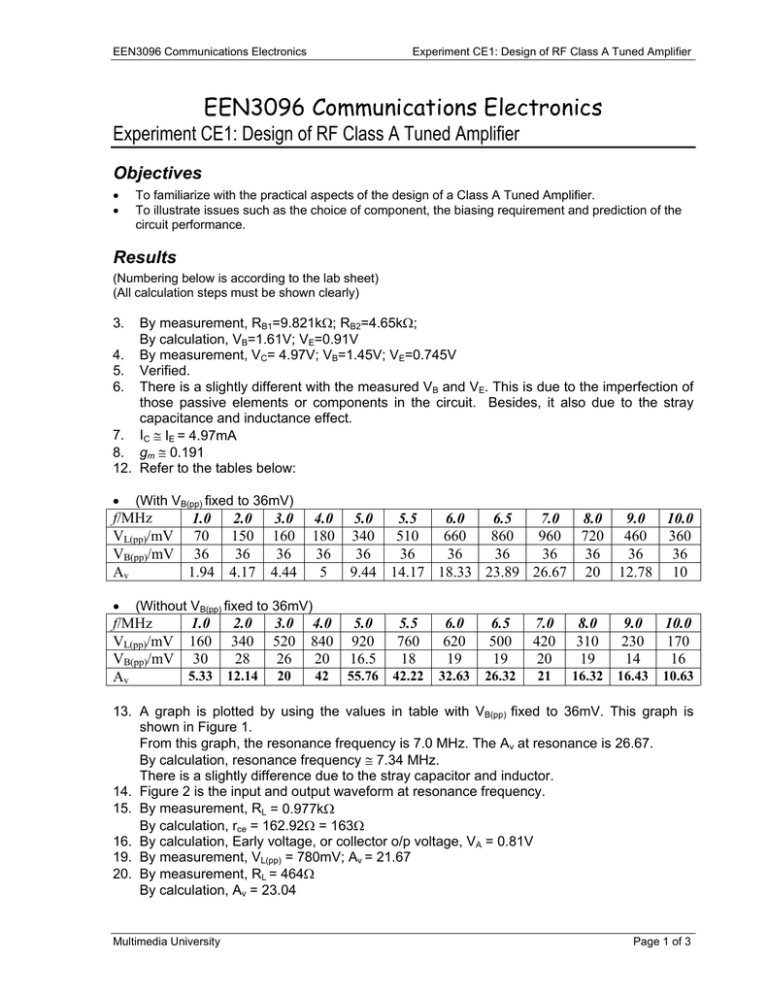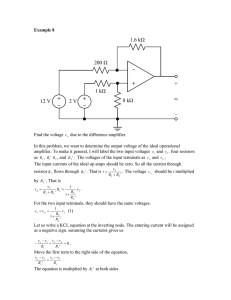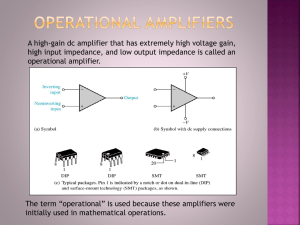
EEN3096 Communications Electronics
Experiment CE1: Design of RF Class A Tuned Amplifier
EEN3096 Communications Electronics
Experiment CE1: Design of RF Class A Tuned Amplifier
Objectives
•
•
To familiarize with the practical aspects of the design of a Class A Tuned Amplifier.
To illustrate issues such as the choice of component, the biasing requirement and prediction of the
circuit performance.
Results
(Numbering below is according to the lab sheet)
(All calculation steps must be shown clearly)
3.
By measurement, RB1=9.821kΩ; RB2=4.65kΩ;
By calculation, VB=1.61V; VE=0.91V
4. By measurement, VC= 4.97V; VB=1.45V; VE=0.745V
5. Verified.
6. There is a slightly different with the measured VB and VE. This is due to the imperfection of
those passive elements or components in the circuit. Besides, it also due to the stray
capacitance and inductance effect.
7. IC ≅ IE = 4.97mA
8. gm ≅ 0.191
12. Refer to the tables below:
•
(With VB(pp) fixed to 36mV)
f/MHz
1.0 2.0 3.0
VL(pp)/mV 70 150 160
VB(pp)/mV 36
36
36
Av
1.94 4.17 4.44
•
4.0
180
36
5
5.0
5.5
6.0
6.5
7.0
8.0
9.0 10.0
340 510
660
860
960 720 460 360
36
36
36
36
36
36
36
36
9.44 14.17 18.33 23.89 26.67 20 12.78 10
(Without VB(pp) fixed to 36mV)
f/MHz
1.0
2.0
3.0
VL(pp)/mV 160 340 520
VB(pp)/mV 30
28
26
5.33 12.14 20
Av
4.0
840
20
5.0
920
16.5
5.5
760
18
6.0
620
19
6.5
500
19
7.0
420
20
8.0
310
19
9.0
230
14
10.0
170
16
42
55.76
42.22
32.63
26.32
21
16.32
16.43
10.63
13. A graph is plotted by using the values in table with VB(pp) fixed to 36mV. This graph is
shown in Figure 1.
From this graph, the resonance frequency is 7.0 MHz. The Av at resonance is 26.67.
By calculation, resonance frequency ≅ 7.34 MHz.
There is a slightly difference due to the stray capacitor and inductor.
14. Figure 2 is the input and output waveform at resonance frequency.
15. By measurement, RL = 0.977kΩ
By calculation, rce = 162.92Ω = 163Ω
16. By calculation, Early voltage, or collector o/p voltage, VA = 0.81V
19. By measurement, VL(pp) = 780mV; Av = 21.67
20. By measurement, RL = 464Ω
By calculation, Av = 23.04
Multimedia University
Page 1 of 3
EEN3096 Communications Electronics
Experiment CE1: Design of RF Class A Tuned Amplifier
There is a slightly difference between the measured and calculated values of Av.
21. VL(pp) = 1060mV; Av = 29.44
By measurement, RL = 1464Ω
By calculation, Av = 28.01
Again, there is a slightly difference between the measured and calculated values of Av.
24. Maximum output voltage swing, VL(pp), max = 8000mV or 8V
Lower voltage threshold = 600mV or 0.6V. This value is approximate to the value of VE,
which is 0.745V.
25. Clipping voltage= 1.8V
Voltage Gain versus Frequency
30
26.67
25
23.89
Voltage Gain, Av
20
20
18.33
15
14.17
12.78
10
10
9.44
4.17
5
5
4.44
1.94
0
0
2
4
6
8
10
12
Frequency, f (MHz)
Figure 1
Multimedia University
Page 2 of 3
EEN3096 Communications Electronics
Experiment CE1: Design of RF Class A Tuned Amplifier
960mV
Voutput
Vinput
36mV
Figure 2
Discussion
Due to instrument error, there is a difficult to maintain the input voltage (VB(pp)) with a value of 36mV.
Hence, I try to do the experiment twice; once with fixed (VB(pp)) to 36mV and once without fixed (VB(pp)) to
36 mV. In order to maintain (VB(pp)) with a value of 36mV, I need to keep on changing the amplitude of
the function generator when its frequency changes.
Besides, due to imperfection of component and stray capacitor, the values that I measured have error,
and are slightly different with the measured value.
Conclusion
A lot of thing have to be consider when design a Class A Amplifier, e.g. the operating frequency range,
input signal amplitude and etc. Hybrid-model for the transistor is essentially accurate and significant
within a frequency range, it provides an easier way for us to design a good amplifier. However, a
capability or accuracy of the amplifier is always limited by the imperfection of those passive elements
and exists of stray capacitor at high frequency and effect of those coupling capacitor and bypass
capacitors.
After this experiment, I gain the basic knowledge of tuned Class A Amplifier and learn the way to design
one. This experiment was proved successfully since the measured resonant frequency is approximate
to the ideal value. I have designed the amplifier with fewer conductors as possible as I can with the
shortest conductance paths (the wires).
Reference
Robert Boylestad, Louis Nashelsky, "Electronic Devices and Circuit Theory", 6th Edition, Prentice Hall,
1996.
This lab report is prepared by Desmond Kho.
Copyright © 2002. All Rights Reserved.
Multimedia University
Page 3 of 3


